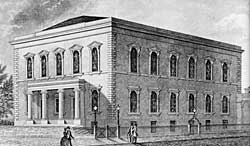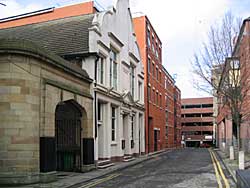< Previous | Contents | Next >
Halifax Place
 Wesleyan chapel, Halifax Place in the late 19th century.
Wesleyan chapel, Halifax Place in the late 19th century.Halifax Place is a queer little street, which connects—by means of a passage at its further end, which is open at certain times—with High Pavement. This passage is of very considerable antiquity and represents a foot-path over somebody's garden. It is mentioned as early as 1531, and the Trinity Guild—the site of whose house we noticed in High Pavement—paid annual acknowledgments for its use. Halifax Place was called "Halifax Lane" in 1435, but in 1744 Deering refers to it as "Jack Nutthall's Lane;" who Jack Nutthall was I have been unable to learn. By 1800 the street is referred to once more as "Halifax Lane," and about 1812 its name was once more changed this time to the modern "Halifax Place."
William Halifax, who seems to be the man after whom the street is named, lived in a house upon the site of what was till recently the Judges' Lodgings in High Pavement, and was a man of considerable eminence in the town. He was bailiff in 1423 and 1424. The office of bailiff was very high, being practically the same as a sheriff; sheriffs of Nottingham being first recorded in 1448 and 1449. Halifax continued his public career until he was made Mayor in 1431 and again in 1440.

Halifax Place in 2004. The Lace Market Theatre is the white building on the left (A Nicholson, 2004).
The street is chiefly remarkable for its religious history, for this quiet little backwater has been a refuge for Dissenting bodies for very many years.
In 1761 there was erected a small chapel upon the site of the present Wesleyan schools by a number of seceders from the Presbyterian congregation worshipping in High Pavement. Through the intercessions of the Rev. George Walker these seceders returned to the fold and the chapel was let or sold to a party of Independents who occupied it till about 1800. It then came into the possession of a body of Calvinistic Methodists, the followers of George Whitfield, whose principal supporter was that extraordinary personage Lady Huntingdon, but after a time it came into the hands of the Wesleyan Methodists, with whom it still remains.
Of the Wesleyans there is more to say. When we were considering Hockley Chapel we saw something of the unfortunate split in the congregation, brought to a head by the attitude taken up by the Rev. Mr. Moon, in consequence of which the congregation was divided into two bodies; the followers of Mr. Moon, who were called the "Conference Party," were fewer in number than their opponents, who were called the "New Connection," and upon the division they found themselves without a place of worship. At first they met in a room in what we now call Heathcote Street, and subsequently at odd times in the original Methodist Chapel called the Octagon.
Through the exertions of the Rev. Mr. Tatham, who traversed the whole country in search of subscriptions, they were able to purchase ground and to build for themselves a chapel upon the site of the present Wesleyan Chapel in Halifax Place. Here they continued to worship until 1847 when the present chapel was built by Mr. Simpson, an architect of Leeds. It was in these premises that the commemoration of the Wesleyan centenary took place on October 25th, 1839. Services were conducted in both Halifax Place and Wesley Chapel, and in the schoolrooms under Halifax Place Chapel upwards of 1,100 persons sat down to tea in celebration of the event.
But the most extraordinary incident in connection with nonconformist methods of bygone times connected with Halifax Place occurred in 1770. A few years previous to that date a community had been formed which called itself the "New Connection of General Baptists;" what their particular shibboleth was does not concern us, but they were doing extremely badly, they had hired a room in Halifax Place in which to conduct their religious services, and in spite of their utmost endeavours they were not attracting very much attention, and very few converts were joining them. And then occurred one of the most appalling incidents of religious development which it is possible to imagine. A man named Cooper Hall had been convicted of robbing the mail and received sentence of death. In the short interval betwixt sentence and execution two of these General Baptists managed to obtain access to the condemned man and exhorted him, apparently with good effect, to repent of his sins and prepare himself for his doom. They attended him to the scaffold and after the execution the corpse was conveyed to the neighbourhood of their preaching-room in Halifax Place and was placed on the head of a cask in the open air. Crowds came to see this ghastly sight and Mr. Tarratt, one of the two members who had attended Hall to the scaffold, standing upon another cask, proceeded to deliver a discourse which so much impressed the audience that from this moment the General Baptists in Nottingham dated the prosperity of their cause. Returning to High Pavement, we find upon its southern side the Shire Hall, which is surely one of the most remarkable buildings in the whole of England ; it is, I believe, unique, and a portion of it is considered the smallest civil parish in the whole kingdom, having but two voters, the custodian and his wife, who have to go to Wilford to register their suffrages, for this tiny parish is incorporated in the County although its geographical situation is in the heart of the City. This curious anomaly represents an exceedingly interesting history. In 1446 Henry VI. made Nottingham into a County Corporate, and its official title to-day is the City and County of the City of Nottingham, but when he conferred this privilege upon the ancient borough Henry VI. expressly excepted the Castle and "the king's house upon High Pavement," and this king's house stood upon the site of a portion of the present Shire Hall. It was used as a prison, though for how long a period it had been put to such use is uncertain. We know that there was a prison in Nottingham during the reign of King John, but the evidence seems to point to the fact that this prison was the old Town Hall which stood in Weekday Cross and which was swept away during the Railway alterations about 1900.
Up to 1532, that is till the reign of King Henry VIII., the felons' prison for the counties of Nottingham and Derbyshire were under one sheriff, for both these counties were in the hands of one sheriff until 1568, and this county prison appears to have been underneath the east end of the Shire Hall. The fact that King Henry VI. excepted the King's house from his grant of jurisdiction to Nottingham seems to point to the fact that other communities than Nottingham had some rights over it, and it may be that these rights were those of the felons. How long before that date this prison was used we cannot say. Deering even hazards the suggestion that it went back to the time of King Alfred, though I think his evidence for this is very slender. At any rate, it is of exceeding antiquity.
